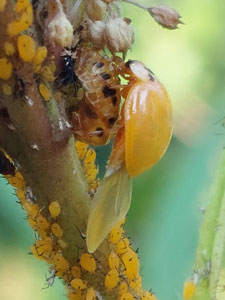
By Jean Ponzi
This Milkweed was Planted for Monarchs
Look close with guest columnist Besa Schweitzer into Milkweed’s wildly bugged-out world.
My neighbor planted a Swamp Milkweed on the edge of her patio to attract monarch butterflies to her garden.
Swamp milkweed (Asclepias incarnata) may be their most preferred food source of the milkweed genus, the only plants monarchs (Danaus plexippus) can eat during their caterpillar stage. The flowers bloomed but the monarchs didn’t come. Sometimes it can take some time for an adult monarch to find a new source of host plant.
Eventually, the monarchs will arrive, seeking out each milkweed to serve as the host plant for a new generation. First the milkweed leaves are colonized by aphids.
Orange milkweed aphids, Aphis nerii, are an introduced species that clones itself instead of reproducing sexually. When aphids colonize a plant, many gardeners reach for the insecticides but when you are gardening for monarchs, insecticides, even organic insecticidal soap, would kill the very species you are trying to attract. It is best to just leave them alone, let the food web naturally form. The predators will come.
Of course, it’s very hard to watch a plant you have nurtured from a seed be damaged by an invasive aphid, sucking all its life fluids. But patience can bring exciting results.
A few days later we were having coffee on her patio with the attacked and suffering milkweed standing nearby. The aphids were still present in force but now there were also a few black and orange striped lady beetle nymphs, Coccinellidae, systematically piercing aphids to suck them dry and leaving a path of aphid husks behind. On closer inspection we found golden eggs clustered under the leaves in tight formation where the lady beetles had emerged.
More pale eggs nearby were suspended on threads, these are the eggs of the aphid lions, Chrysoperla sp. Born so ferocious that their parents must separate them at birth on their own thread. Aphid lions look like tiny alligators, snapping up aphids in their strong jaws, and mature into delicate green lacewings.
We also find flower fly youngsters, Syrphidae. These white, pointy-ended maggots parasitize aphids, turning them into zombies as the maggot develops inside. When the maggots emerge as adults, they are important pollinators of the plant they just protected from aphids.
And, jackpot, under a leaf is the tiny crystal meringue of a monarch egg.
Who needs TV when you can sit near a swamp milkweed?
Watch battles rage from stem to stem, birth and death, eggs becoming nymphs becoming adults, so many different species doing what they do best. Plants are eaten by aphids, then eaten by beetles, in turn then eaten by birds, who then disperse to far corners and eventually be eaten themselves. Eggs are carefully laid on a selected host and hatch and eat and grow. The lucky few that avoid predation become adults to start the cycle over again.
We could (and do) sit here for hours, fascinated by the drama in front of our eyes. This milkweed, planted to attract monarchs, has summoned an entire ecosystem.
Native gardening specialist Besa Schweitzer is author of The Wildflower Garden Planner, an interactive guide that draws on her deep, diverse experiences growing wild, in joyful partnership with Nature. Connect at www.BesaGrows.com. Thanks, Besa, for sharing this piece being read nationally this summer, in Wild Ones Journal.


